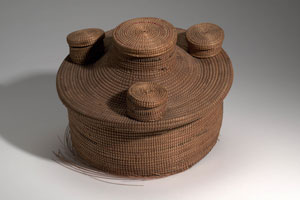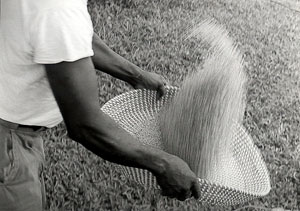 Introduction | What is a basket? | African Rice and Baskets | The Lowcountry | Rice and Baskets Post Civil War to the Present | The Sweetgrass Revolution | African Baskets Today    Wide winnowing baskets, known as fanners, were the earliest and most important type of coiled basketry made by Africans in North America. From the introduction of rice in the late 1600s to well into the 20th century, fanner baskets were used to separate rice grains from husks. Pounded grains of raw rice were placed in a fanner and tossed into the air or dropped from one basket to another. After the wind blew away the chaff, the rice was ready for cooking. Fanners were also used to carry food and even to cradle babies while their mothers worked in the fields. Wide winnowing baskets, known as fanners, were the earliest and most important type of coiled basketry made by Africans in North America. From the introduction of rice in the late 1600s to well into the 20th century, fanner baskets were used to separate rice grains from husks. Pounded grains of raw rice were placed in a fanner and tossed into the air or dropped from one basket to another. After the wind blew away the chaff, the rice was ready for cooking. Fanners were also used to carry food and even to cradle babies while their mothers worked in the fields.In Africa coiled or woven baskets continue to be used to process grain and to cover bowls of food. Coiled baskets made in Senegal and Angola look similar to African American fanner baskets, whereas fanners made in other places, such as Sierra Leone, are woven rather than coiled. Preference for one technique over another most likely is due to the kinds of plant materials available.   Coiled baskets are crafted from one continuous strand or from bundles of fibers sewn together in a spiral. In contrast, woven baskets are made from discontinuous elements that are interlaced and typically held together by a binding at the edge. Basket makers around the world have invented many variations on these basic methods of creating elaborate objects from simple strands of flexible fiber. Baskets have been produced for many purposes, more so in the past than today. They serve as strainers and containers, traps and hats, beehives and bonnets, even houses and rafts. They can be porous or watertight, flexible or rigid. The uses of baskets, the materials available to make them and the skill and inventiveness of basket makers determine the ultimate appearance of baskets. Coiled baskets are crafted from one continuous strand or from bundles of fibers sewn together in a spiral. In contrast, woven baskets are made from discontinuous elements that are interlaced and typically held together by a binding at the edge. Basket makers around the world have invented many variations on these basic methods of creating elaborate objects from simple strands of flexible fiber. Baskets have been produced for many purposes, more so in the past than today. They serve as strainers and containers, traps and hats, beehives and bonnets, even houses and rafts. They can be porous or watertight, flexible or rigid. The uses of baskets, the materials available to make them and the skill and inventiveness of basket makers determine the ultimate appearance of baskets.  African basket makers often combine different techniques and materials in a single basket and add color or beading for decoration. On rice plantations in the Lowcountry--the coastal region from North Carolina to Florida--the predominant technique was coiling and the preferred materials were bulrush (Juncus roemerianus) bound with splints of white oak (Quercus alba) or stalks of saw palmetto (Serenoa repens). Today, Lowcountry basket makers prefer to use sweetgrass (Muhlenbergia sericea) in combination with bulrush and pine needles (Pinus palustris), sewn with strips of palmetto leaf (Sabal palmetto). African basket makers often combine different techniques and materials in a single basket and add color or beading for decoration. On rice plantations in the Lowcountry--the coastal region from North Carolina to Florida--the predominant technique was coiling and the preferred materials were bulrush (Juncus roemerianus) bound with splints of white oak (Quercus alba) or stalks of saw palmetto (Serenoa repens). Today, Lowcountry basket makers prefer to use sweetgrass (Muhlenbergia sericea) in combination with bulrush and pine needles (Pinus palustris), sewn with strips of palmetto leaf (Sabal palmetto).  On both sides of the Atlantic Ocean, the art of basketry continues to be passed down from generation to generation. In the Lowcountry, as in many parts of Africa, virtuoso basket makers invent forms, experiment with new materials and perfect the techniques they have learned from their parents and grandparents. A child begins by sewing the bottom of a basket while an older relative builds up the sides, pointing out how to give the basket shape and strength. Through this process certain baskets evoke memories of loved ones and link generations. On both sides of the Atlantic Ocean, the art of basketry continues to be passed down from generation to generation. In the Lowcountry, as in many parts of Africa, virtuoso basket makers invent forms, experiment with new materials and perfect the techniques they have learned from their parents and grandparents. A child begins by sewing the bottom of a basket while an older relative builds up the sides, pointing out how to give the basket shape and strength. Through this process certain baskets evoke memories of loved ones and link generations. While it is unknown what kinds of baskets were made in Africa 300 years ago, striking similarities between African and African American baskets point to a common cultural heritage. Besides utilitarian fanners, distinctive stepped-lid baskets and stacked baskets are made on both continents. In the Congo region, the stepped form, also found on grave mounds, might refer to the passage of the soul from birth to death. While African Americans have made these baskets for generations, they attribute different meanings to the sculptural forms. |